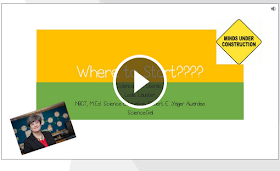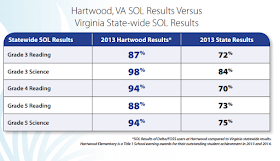Comment:
Imagine sitting over coffee with a colleague discussing the latest trends in science education....that's what Science Gal is all about...
Pages
▼
Tuesday, August 18, 2015
Why science and literacy are a great match
Comment:
Tuesday, August 4, 2015
Step 2: What about Lesson Planning?
Once you have your year planned, with a general idea of your scope and sequence and units that may overlap with natural connections, you are ready to move into a more specific, daily lesson plan. Make sure you read all ten especially my favorite one...it's at the bottom!
Just FYI - I did not recieve any FREE products from these sources. These are reviews that I have made just by looking at them online. I want you to know that they are not based on Freebies and I have not purchased any (except the one at the end).
There are a million different types of lesson plan formats. Some you can buy at teacher stores, some are created and bound together on sites like Etsy and others are found on Teachers Pay Teachers. In fact, just doing this research tonight I found TONS of resources. How you choose to plan is up to you and your individual needs.
So here are the Top Ten that I have found online and the links to help you find them.

1. Erin Condren Lesson Planner I have a few friends who swear by this lesson planning format. It's colorful and fun, but in my opinion, at $59 a little too steep for my budget.
2. Farm Girl Journals
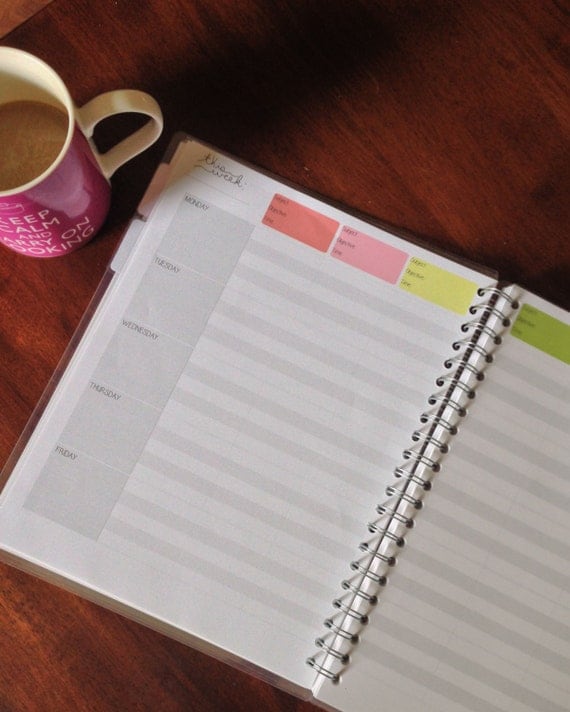 This is simliar to the Erin Condren one, but slightly less expensive at $45. Both of these formats have been created by teachers and have color coded sections and a nice spiral binder. * Included are a teacher and substitute information section
This is simliar to the Erin Condren one, but slightly less expensive at $45. Both of these formats have been created by teachers and have color coded sections and a nice spiral binder. * Included are a teacher and substitute information section
* 40 two page weekly lesson plan spreads
* 25 double sided blank charts to use as you wish - grades, attendance, check lists, etc.
* 25 double sided notes section to keep track of faculty meetings, planning notes, parent conferences, etc..
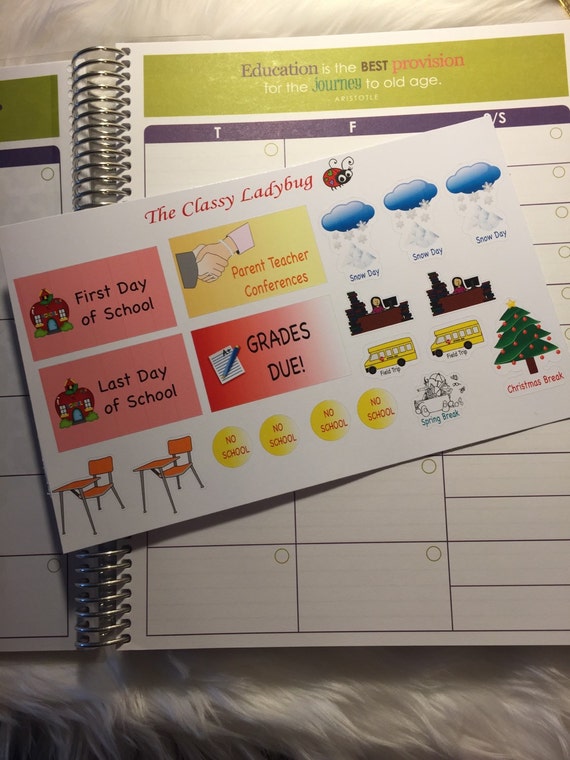
3. More resources are found at Etsy including some stickers and supplements for these journals. Sometimes it just fun to have stickers! You can get stickers, tabs and more ranging from $4 and up.

4. Another place to look is your typical teachers catalogs and stores. These are pretty traditional and standard. Quite frankly they haven't changed much in 25 years. But they serve the purpose and many teachers are very comfortable with them. In other words, there is nothing wrong with it! I found this one from Carson Delossa for just $7.99.
If you are looking towards more of a customized look, then head over to Teacher's Pay Teachers. Here you can find just about anything for just about any type of classroom.
 5. Teacher Planner from A Modern Teacher.
5. Teacher Planner from A Modern Teacher.
This planner has forms for everything that you can choose and print. Ther are editable Year at a glance, weekly planning, daily planning, and forms galore! There are several different covers and color options for $14.50.
 6. The Ultimate Teacher Binder by One Stop Teacher Shop. This customizable and editable resource has over 1,200 forms. There are forms for planning, organizing and more. I like it because it has lots of "cute" covers. And when days are rough, its nice to have "cute things" around you. LOL! The price is only $11.99.
6. The Ultimate Teacher Binder by One Stop Teacher Shop. This customizable and editable resource has over 1,200 forms. There are forms for planning, organizing and more. I like it because it has lots of "cute" covers. And when days are rough, its nice to have "cute things" around you. LOL! The price is only $11.99.
 8. Sticky Note Planbook: This is a real teacher created idea from The Wise and Witty Teacher . This teacher explains how she made it when you click onto her blog. Basically, she traced the sticky notes to make boxes and then placed different colored notes for different subjects. I like it! When I used to use a paper template I often had to cover up the plan with a sticky note when things changed. For example if I had a plan for a week, and after formative assessments I knew we had to rethink the plan...I just put a sticky note on it. The cost? Well...it depends if you have a spiral notebook and sticky notes already then it is FREE. If not, then the cost is about $5-10. Truthfully, if I didn't love the last resource this is what I would probably be using.
8. Sticky Note Planbook: This is a real teacher created idea from The Wise and Witty Teacher . This teacher explains how she made it when you click onto her blog. Basically, she traced the sticky notes to make boxes and then placed different colored notes for different subjects. I like it! When I used to use a paper template I often had to cover up the plan with a sticky note when things changed. For example if I had a plan for a week, and after formative assessments I knew we had to rethink the plan...I just put a sticky note on it. The cost? Well...it depends if you have a spiral notebook and sticky notes already then it is FREE. If not, then the cost is about $5-10. Truthfully, if I didn't love the last resource this is what I would probably be using.
 9. And the reason for this is because it is what I use and is the newest up and coming tools. This from Tracie Clausen at Dragonflies in First and includes 8 editable cover options, 6 autofill forms and 81 premade templates to meet all of your needs. These can be printed, but also are compatable with your phone and ipad. Genius! Purchase price is $15.00.
9. And the reason for this is because it is what I use and is the newest up and coming tools. This from Tracie Clausen at Dragonflies in First and includes 8 editable cover options, 6 autofill forms and 81 premade templates to meet all of your needs. These can be printed, but also are compatable with your phone and ipad. Genius! Purchase price is $15.00.
 10. My favorite and the one I use everyday is www.planbook.com. I can't say enough about this planbook. Three years ago, my colleague, Elena Beard, convinced us to try it in fourth grade. We were nervous at first, but now we LOVE it. First, it is all online, both ipad and for computers, but you can print it or share it (weekly or daily). My entire team uses it -- why? We can share lessons electronically, we can attach documents and worksheets to the lesson plans, we can edit the classes and even add snow days which bumps the lesson plans over to the next day. However, my favorite feature is the dropdown feature where you can embed your standards with a click of the button. At the end of the year, it saves all your plans for the next year and you just edit them as needed. It is the best $12 I have ever spent. I hope you will search this site out like we did, because it is the BEST lesson plan format that I have ever used.
10. My favorite and the one I use everyday is www.planbook.com. I can't say enough about this planbook. Three years ago, my colleague, Elena Beard, convinced us to try it in fourth grade. We were nervous at first, but now we LOVE it. First, it is all online, both ipad and for computers, but you can print it or share it (weekly or daily). My entire team uses it -- why? We can share lessons electronically, we can attach documents and worksheets to the lesson plans, we can edit the classes and even add snow days which bumps the lesson plans over to the next day. However, my favorite feature is the dropdown feature where you can embed your standards with a click of the button. At the end of the year, it saves all your plans for the next year and you just edit them as needed. It is the best $12 I have ever spent. I hope you will search this site out like we did, because it is the BEST lesson plan format that I have ever used.
Comment:
Just FYI - I did not recieve any FREE products from these sources. These are reviews that I have made just by looking at them online. I want you to know that they are not based on Freebies and I have not purchased any (except the one at the end).
There are a million different types of lesson plan formats. Some you can buy at teacher stores, some are created and bound together on sites like Etsy and others are found on Teachers Pay Teachers. In fact, just doing this research tonight I found TONS of resources. How you choose to plan is up to you and your individual needs.
So here are the Top Ten that I have found online and the links to help you find them.

1. Erin Condren Lesson Planner I have a few friends who swear by this lesson planning format. It's colorful and fun, but in my opinion, at $59 a little too steep for my budget.
2. Farm Girl Journals
 This is simliar to the Erin Condren one, but slightly less expensive at $45. Both of these formats have been created by teachers and have color coded sections and a nice spiral binder. * Included are a teacher and substitute information section
This is simliar to the Erin Condren one, but slightly less expensive at $45. Both of these formats have been created by teachers and have color coded sections and a nice spiral binder. * Included are a teacher and substitute information section * 40 two page weekly lesson plan spreads
* 25 double sided blank charts to use as you wish - grades, attendance, check lists, etc.
* 25 double sided notes section to keep track of faculty meetings, planning notes, parent conferences, etc..

3. More resources are found at Etsy including some stickers and supplements for these journals. Sometimes it just fun to have stickers! You can get stickers, tabs and more ranging from $4 and up.

4. Another place to look is your typical teachers catalogs and stores. These are pretty traditional and standard. Quite frankly they haven't changed much in 25 years. But they serve the purpose and many teachers are very comfortable with them. In other words, there is nothing wrong with it! I found this one from Carson Delossa for just $7.99.
If you are looking towards more of a customized look, then head over to Teacher's Pay Teachers. Here you can find just about anything for just about any type of classroom.
 5. Teacher Planner from A Modern Teacher.
5. Teacher Planner from A Modern Teacher. This planner has forms for everything that you can choose and print. Ther are editable Year at a glance, weekly planning, daily planning, and forms galore! There are several different covers and color options for $14.50.
 6. The Ultimate Teacher Binder by One Stop Teacher Shop. This customizable and editable resource has over 1,200 forms. There are forms for planning, organizing and more. I like it because it has lots of "cute" covers. And when days are rough, its nice to have "cute things" around you. LOL! The price is only $11.99.
6. The Ultimate Teacher Binder by One Stop Teacher Shop. This customizable and editable resource has over 1,200 forms. There are forms for planning, organizing and more. I like it because it has lots of "cute" covers. And when days are rough, its nice to have "cute things" around you. LOL! The price is only $11.99. - 7. FREE! This is a really great site that I ran across today on Pinterest from the Curriculum Corner. First, the price is right! Second, it has a lot of pages for planning and organizing that you can choose and print off for a binder of your choice. Samples include: Parent contacts, IEP at a Glance, Weekly lesson planning, Password check list, and more! This is not as colorful, but it is FREE.
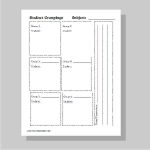
 8. Sticky Note Planbook: This is a real teacher created idea from The Wise and Witty Teacher . This teacher explains how she made it when you click onto her blog. Basically, she traced the sticky notes to make boxes and then placed different colored notes for different subjects. I like it! When I used to use a paper template I often had to cover up the plan with a sticky note when things changed. For example if I had a plan for a week, and after formative assessments I knew we had to rethink the plan...I just put a sticky note on it. The cost? Well...it depends if you have a spiral notebook and sticky notes already then it is FREE. If not, then the cost is about $5-10. Truthfully, if I didn't love the last resource this is what I would probably be using.
8. Sticky Note Planbook: This is a real teacher created idea from The Wise and Witty Teacher . This teacher explains how she made it when you click onto her blog. Basically, she traced the sticky notes to make boxes and then placed different colored notes for different subjects. I like it! When I used to use a paper template I often had to cover up the plan with a sticky note when things changed. For example if I had a plan for a week, and after formative assessments I knew we had to rethink the plan...I just put a sticky note on it. The cost? Well...it depends if you have a spiral notebook and sticky notes already then it is FREE. If not, then the cost is about $5-10. Truthfully, if I didn't love the last resource this is what I would probably be using.
Technology Resources are up last.
 9. And the reason for this is because it is what I use and is the newest up and coming tools. This from Tracie Clausen at Dragonflies in First and includes 8 editable cover options, 6 autofill forms and 81 premade templates to meet all of your needs. These can be printed, but also are compatable with your phone and ipad. Genius! Purchase price is $15.00.
9. And the reason for this is because it is what I use and is the newest up and coming tools. This from Tracie Clausen at Dragonflies in First and includes 8 editable cover options, 6 autofill forms and 81 premade templates to meet all of your needs. These can be printed, but also are compatable with your phone and ipad. Genius! Purchase price is $15.00.  10. My favorite and the one I use everyday is www.planbook.com. I can't say enough about this planbook. Three years ago, my colleague, Elena Beard, convinced us to try it in fourth grade. We were nervous at first, but now we LOVE it. First, it is all online, both ipad and for computers, but you can print it or share it (weekly or daily). My entire team uses it -- why? We can share lessons electronically, we can attach documents and worksheets to the lesson plans, we can edit the classes and even add snow days which bumps the lesson plans over to the next day. However, my favorite feature is the dropdown feature where you can embed your standards with a click of the button. At the end of the year, it saves all your plans for the next year and you just edit them as needed. It is the best $12 I have ever spent. I hope you will search this site out like we did, because it is the BEST lesson plan format that I have ever used.
10. My favorite and the one I use everyday is www.planbook.com. I can't say enough about this planbook. Three years ago, my colleague, Elena Beard, convinced us to try it in fourth grade. We were nervous at first, but now we LOVE it. First, it is all online, both ipad and for computers, but you can print it or share it (weekly or daily). My entire team uses it -- why? We can share lessons electronically, we can attach documents and worksheets to the lesson plans, we can edit the classes and even add snow days which bumps the lesson plans over to the next day. However, my favorite feature is the dropdown feature where you can embed your standards with a click of the button. At the end of the year, it saves all your plans for the next year and you just edit them as needed. It is the best $12 I have ever spent. I hope you will search this site out like we did, because it is the BEST lesson plan format that I have ever used.
What do you use for Lesson Planning?
Comment:
Friday, July 17, 2015
Step One: What will the year look like?
Truth be told...I'm a little nervous....I'm launching a new format today for this blog and it makes me a little scared. As a reflective practitioner, I thought...what can I do to make ScienceGal better? How can I express myself in a manner that is easier to understand?
This is what I have come up with - it's still a blog, but with a video/audio component. There will still be visuals, photographs, freebies and also a few things for purchase. ScienceGal has always been a way for me to express what is going on in Science Education. It is based on best practices, sound pedagogy and upcoming trends.
If you read my last post, you will know I am currently on a mission to help teachers take part in a paradigm shift. A shift that will take them from "traditional, silo teaching" to a more all encompasing science centered classroom. I have even uploaded an audio/powerpoint mix to the last blog so that you can "hear" my thoughts as an introduction to this new topic.

So how would you start to think about planning for the year? Oh...in order to see how this works, you will have to listen to the audio component. Leave a comment after you do! I will pick 3 comments and send them the Rube Goldberg Design brief for free! But you have to comment on what you liked, didn't like or other helpful suggestions in order to be placed in the drawing. The drawing will take place on Sunday, August 2nd at 8pm EST. Make sure you leave a comment by then!
Okay...drum roll....here it is! Click on this link to see the presentation.
Comment:
This is what I have come up with - it's still a blog, but with a video/audio component. There will still be visuals, photographs, freebies and also a few things for purchase. ScienceGal has always been a way for me to express what is going on in Science Education. It is based on best practices, sound pedagogy and upcoming trends.
If you read my last post, you will know I am currently on a mission to help teachers take part in a paradigm shift. A shift that will take them from "traditional, silo teaching" to a more all encompasing science centered classroom. I have even uploaded an audio/powerpoint mix to the last blog so that you can "hear" my thoughts as an introduction to this new topic.

So how would you start to think about planning for the year? Oh...in order to see how this works, you will have to listen to the audio component. Leave a comment after you do! I will pick 3 comments and send them the Rube Goldberg Design brief for free! But you have to comment on what you liked, didn't like or other helpful suggestions in order to be placed in the drawing. The drawing will take place on Sunday, August 2nd at 8pm EST. Make sure you leave a comment by then!
Okay...drum roll....here it is! Click on this link to see the presentation.
Don't forget to leave a comment!
PS - I don't know why some of the text is messed up in the presentation. It didn't look cut off when I was recording it. I am not sure why it changed when it was published.
Comment:
Tuesday, July 14, 2015
Paradigm Shift....

I want to share with you the paradigm shift that I have been working on for the past three years. You see, I am still a classroom teacher. And as a classroom teacher, I have noticed that focusing solely on math and reading was boring the kids to death! I looked out at my room a few years ago to faces that were unmotivated, bored, and simply uncaring about what was happening in the classroom. We had a two hour reading block - where kids were pulled in every direction for intervention and reteaching. It was a mess.
So, with some guidance and research in my pocket, I decided to redesign the schedule of the day.
- First, I switched the times things were taught. We now started the day with science. The kids had something to look forward to...engaging lessons and active exploration.
- Next, we cut the 2 hour reading block to 1 hour. Why? Well, we decided to purposefully integrate science and social studies with reading and language skills. We infused cause and effect, sequencing, problem/solution, compare and contrast, and more into our content area. (More about this approach to come this summer.) Our reading block was now set aside for a mini-lesson, silent reading and guided reading groups. If intervention groups were to happen, we had them in our classrooms with a reading support teacher.
- Finally, we integrated math skills such as measurement and graphing into science. We made these concepts meaningful and hands-on with a purpose.
What were the results? First and foremost...happier kids. I had students who would have been reticent now actively participating in lessons, conversations and discussions. These students learned new vocabulary in a meaningful way, and they were eager to come to school and get to work. No longer did I see the sea of blank stares...
But of course data talks, right??? Let me share our scores.
You know what else happened? I was happier...because I was actually teaching things the students were interested in. By using Science and Social Studies as our focus, we were making connections all day long. The students took ownership in the role of researcher and practitioner. And it was really cool....
Remember why we went into teaching...before we got squashed by the rules and the testing craziness? Its time to rebel and go back to what we know works for kids.
To watch the video click here.
I look forward to sharing with you how we did it....planning, team work, lesson plans, philosophy, etc... Are you ready to join the Paradigm Shift????
Comment:
Wednesday, May 13, 2015
Springtime = Nature
A few weeks ago I took my class on a field trip to "Friends of the Rappahanock". They are our local grassroots, conservation organization whose prime mission is to help protect our river, wetlands and environment.
 We were blessed with a beautiful day. Our students were treated to a wonderful nature walk along the canal where we saw turtles, birds, and even a little green snake!
We were blessed with a beautiful day. Our students were treated to a wonderful nature walk along the canal where we saw turtles, birds, and even a little green snake!
On this field trip, my students learned what a wetland is and does for the environment. This particular wetland is right in the middle of our little town, just down the hill from the hospital, and yet to most of our students it was a hidden treat that they did not know about.
 Many of our kids come from apartment dwellings where they are latch key kids. Going outside after school to play is not an option. Many of my kid speak of going home and either watching TV or playing video games because their parents are trying to keep them home and safe. I get that..they are working parents who may not be home until 6 or 7 at night. On the flip side, I have students from "middle class" families as well who are so busy every night with sports, church, dance, etc... that they, too, have no time to just "play"
Many of our kids come from apartment dwellings where they are latch key kids. Going outside after school to play is not an option. Many of my kid speak of going home and either watching TV or playing video games because their parents are trying to keep them home and safe. I get that..they are working parents who may not be home until 6 or 7 at night. On the flip side, I have students from "middle class" families as well who are so busy every night with sports, church, dance, etc... that they, too, have no time to just "play"
While we were walking I asked my kids, "Have you ever caught a frog?" Astoundingly, most of them said no. Throughout the day, they were fascinated by inchworms (they were everywhere that day!), butterflies and the outdoor air. You could see the stress melting away as they simply enjoyed nature at its best.
We enjoyed the beautiful artwork that was also incorporated into the location. Check out this fish! It has paintings that show areas around our town as well as conservation efforts.

So I leave you with this...during this stressful state testing time...don't forget to get outside and enjoy nature with your kids. You may be the only role model they have for simply relaxing and enjoying the moment.
Comment:
 We were blessed with a beautiful day. Our students were treated to a wonderful nature walk along the canal where we saw turtles, birds, and even a little green snake!
We were blessed with a beautiful day. Our students were treated to a wonderful nature walk along the canal where we saw turtles, birds, and even a little green snake!On this field trip, my students learned what a wetland is and does for the environment. This particular wetland is right in the middle of our little town, just down the hill from the hospital, and yet to most of our students it was a hidden treat that they did not know about.
 Many of our kids come from apartment dwellings where they are latch key kids. Going outside after school to play is not an option. Many of my kid speak of going home and either watching TV or playing video games because their parents are trying to keep them home and safe. I get that..they are working parents who may not be home until 6 or 7 at night. On the flip side, I have students from "middle class" families as well who are so busy every night with sports, church, dance, etc... that they, too, have no time to just "play"
Many of our kids come from apartment dwellings where they are latch key kids. Going outside after school to play is not an option. Many of my kid speak of going home and either watching TV or playing video games because their parents are trying to keep them home and safe. I get that..they are working parents who may not be home until 6 or 7 at night. On the flip side, I have students from "middle class" families as well who are so busy every night with sports, church, dance, etc... that they, too, have no time to just "play" While we were walking I asked my kids, "Have you ever caught a frog?" Astoundingly, most of them said no. Throughout the day, they were fascinated by inchworms (they were everywhere that day!), butterflies and the outdoor air. You could see the stress melting away as they simply enjoyed nature at its best.
We enjoyed the beautiful artwork that was also incorporated into the location. Check out this fish! It has paintings that show areas around our town as well as conservation efforts.
Another hidden treasure was this rock that was painted and posted next to a beautiful tree. It was put there as a retirement gift for the former director. I was really moved by it because...well, we all love the Lorax. Plus I thought, we could do this at our school too!

So I leave you with this...during this stressful state testing time...don't forget to get outside and enjoy nature with your kids. You may be the only role model they have for simply relaxing and enjoying the moment.
Comment:
Saturday, May 2, 2015
I wrote an article!!!
Many of you who read my blog know that I am a die hard FOSS fan. I have been using FOSS in my fourth grade classroom for over seven years with staggering results and understanding. Six years ago, I also began consulting for the company which has led to many exciting training opportunities in Connecticut, Philadelphia and even San Fransisco. I have been blessed to reach out and train teachers in Virginia Beach, Farmville, Winchester and the little towns of Warsaw and Giles Co. I have met some amazing teachers who truly want to engage their students and learn more about good science education.

I have also worked very hard in my own school to support and grow science education. But, I have never once done these things alone. With the support of Kip Bisignano, my FOSS sales rep, and many others we have built a pretty amazing little school.
Recently, I was asked to write an article to show what we have done to create our STEAM school for the FOSS newsletter. To read more about what we are doing at our "little school with big dreams" you can access the newsletter at this link.

I hope that you will see that this is a TEAM effort, not one that can be done by one person. You must first have a vision, a strong leader (at your school and district), and a professional learning community with staff who teach "kids not test scores".
Those of you who read my blog may also wonder why I haven't been as active with my posts lately. After reading this, you will probably see why! (LOL) Been a little busy....on top of two challenging classrooms the past two years with some serious needs.
However, I have recently come to realize that this is what feeds my soul. I have missed blogging about the wonderful things my kids are doing (challenging or not). We have learned how to use tableaus to show understanding of concepts in the dramatic art form, visual arts and music. We are working on creating a nature trail at our school with a partnership from a local Native American group (the Patawomack tribe) and an Eagle Scout to create a replica of a longhouse in our woods. Next year, we are hoping to plan and implement a curriculum to expose our students more to the outdoors. Ideas include an outdoor stage, trail, music wall and more. My team mate and I have successfully implemented reading in the content area in our science and social studies blocks; specifically text structures of cause/effect, compare/contrast, fact/opinion, problem & solutions and even main idea. My personal goal for next year is to look at special education students and ways to modify instruction in the classroom so that they can be successful in science as well as math and reading.
So, I am challenging myself to write at least two blogs a month for the next year. I am hopeful to meet this goal with your encouragement and support!
Comment:

I have also worked very hard in my own school to support and grow science education. But, I have never once done these things alone. With the support of Kip Bisignano, my FOSS sales rep, and many others we have built a pretty amazing little school.
Recently, I was asked to write an article to show what we have done to create our STEAM school for the FOSS newsletter. To read more about what we are doing at our "little school with big dreams" you can access the newsletter at this link.

I hope that you will see that this is a TEAM effort, not one that can be done by one person. You must first have a vision, a strong leader (at your school and district), and a professional learning community with staff who teach "kids not test scores".
Those of you who read my blog may also wonder why I haven't been as active with my posts lately. After reading this, you will probably see why! (LOL) Been a little busy....on top of two challenging classrooms the past two years with some serious needs.
However, I have recently come to realize that this is what feeds my soul. I have missed blogging about the wonderful things my kids are doing (challenging or not). We have learned how to use tableaus to show understanding of concepts in the dramatic art form, visual arts and music. We are working on creating a nature trail at our school with a partnership from a local Native American group (the Patawomack tribe) and an Eagle Scout to create a replica of a longhouse in our woods. Next year, we are hoping to plan and implement a curriculum to expose our students more to the outdoors. Ideas include an outdoor stage, trail, music wall and more. My team mate and I have successfully implemented reading in the content area in our science and social studies blocks; specifically text structures of cause/effect, compare/contrast, fact/opinion, problem & solutions and even main idea. My personal goal for next year is to look at special education students and ways to modify instruction in the classroom so that they can be successful in science as well as math and reading.
So, I am challenging myself to write at least two blogs a month for the next year. I am hopeful to meet this goal with your encouragement and support!
Comment:
Monday, January 12, 2015
Art and Science Integration - searching for Weather in Paintings
Speaking of visual learners....let me share with you an exciting project we have been working on at my school. Slowly but surely we are becoming an Arts Integration school in partnership with the Kennedy Center in Washington D.C. (CETA). Recently, the fourth grade team participated in a unit involving weather and the arts (adapted from an ArtsEdge lesson found here).
We started with a power point: of paintings that we found online and in the Arts Edge lesson. Gather the students around a window in the classroom and look outside to observe the weather. Ask the students the following questions:
Creating Stage:
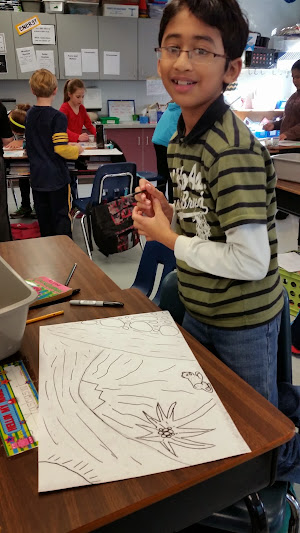
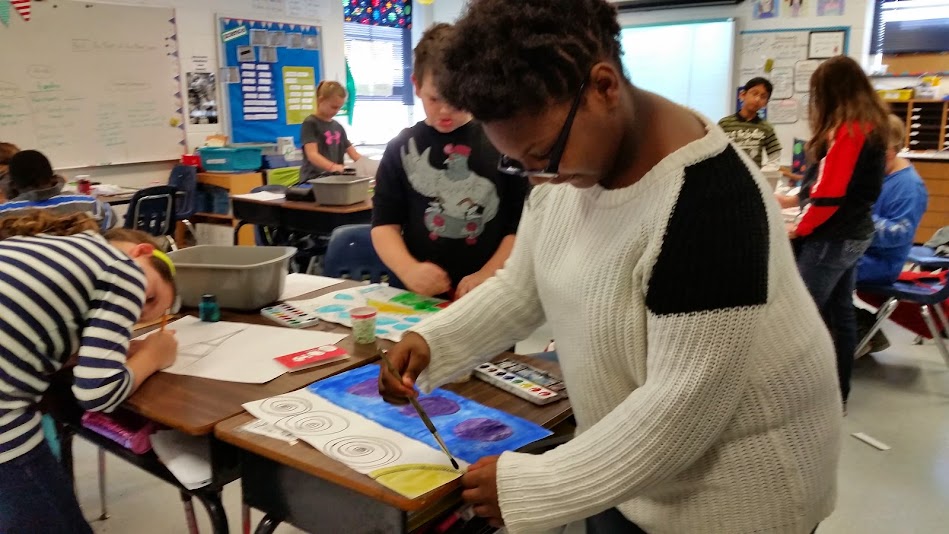
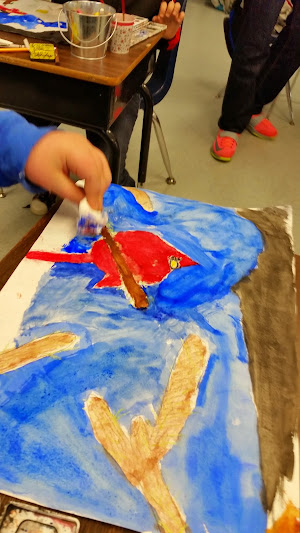
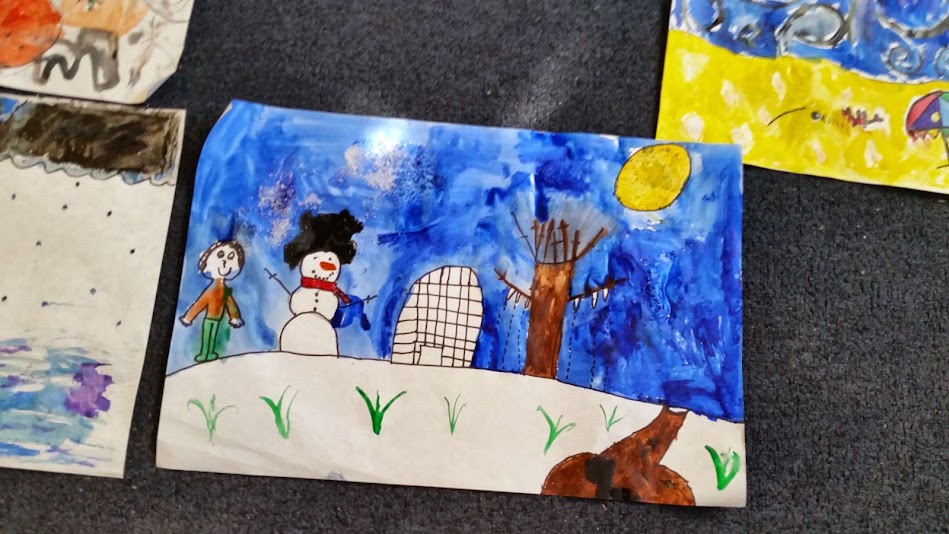
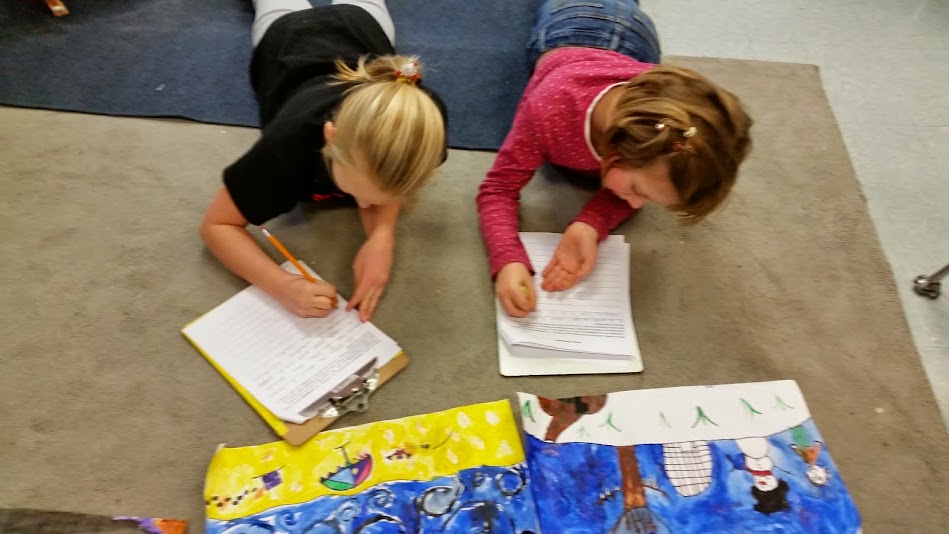
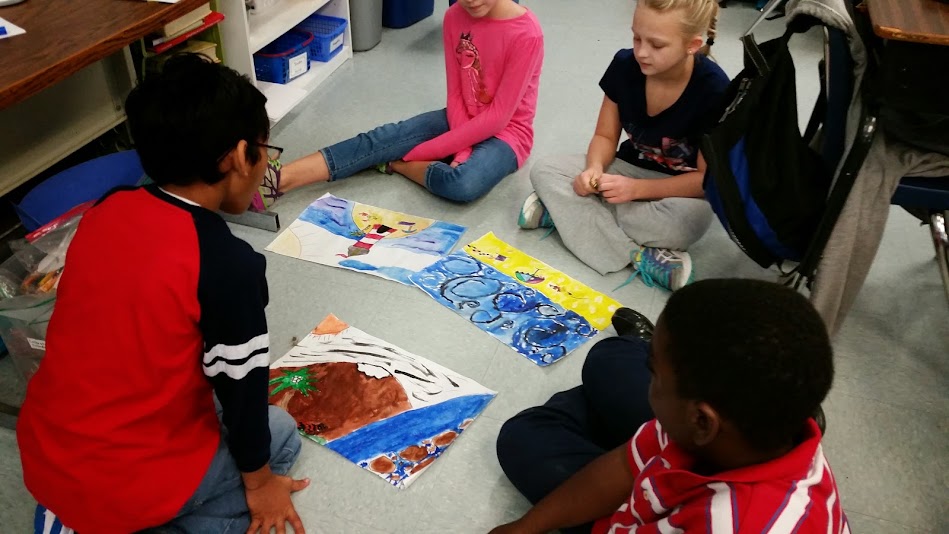
Comment:
We started with a power point: of paintings that we found online and in the Arts Edge lesson. Gather the students around a window in the classroom and look outside to observe the weather. Ask the students the following questions:
- What is the weather like today?
- What is the current season? How you describe the palette of colors associated with this season?
- What objects or changes in the environment (the sky, trees, ground or sidewalks, clothing, etc.) provide clues about weather and/or the season?
- What is your favorite kind of weather and why?
After students have responded to these questions, have them look at the paintings in the ENGAGE tab of the resource carousel. As students look at the paintings online, ask them:
- How is light expressed in the painting?
- What kind of feeling or mood does the painting generate?
- How are the colors used to convey light or darkness?
BUILD KNOWLEDGE
Distribute Elements of Art handout. Discuss the elements of color, shape, and texture with students. Look again at the paintings in the resource carousel; review and analyze the pictures with students, while discussing the use of color, shape, and texture to portray a particular weather condition.
Have students select, analyze, and discuss their favorite paintings. Have each student choose a favorite painting, and break the students into groups according to their favorite paintings. Students can print out the paintings directly from the online interactive, or you may wish to bring into class prints of these paintings. Within the groups, students should share their thoughts and feelings about why they liked the pictures, discussing the elements of art such as color, shape, and texture. Students should use the Elements of Art handout as a reference point during their discussion. Have them present their responses as a group in front of the class.
On the next day, we post a painting and ask the kids to list words that describe color, texture, light on a class chart
- Start by reading Look! Seeing the Light in Art by Gillian Wolfe - page 27
- thick strokes give the surface a rich and craggy feel
- why did Van Gogh use thick, textured paint? (active feeling)
- Smooth texture is less active and calming
- What are some other ways artists make texture?
- What are some ways that artists create texture?
- They brush paint on in watery strokes and thick drips.
- They put paint down in short, fat dabs and long, sleek strokes.
- They twirl their brushes to make circles and curls.
- They apply paint in thick layers that stick out from the canvas.
- They put different colors on top of each other.
- They mix in sand, dirt, or other materials into the paint.
- They add white highlights to make things look shiny.
- They scratch through paint to show colors underneath.
- Next read about Cold and Hot light - page 12-13
- Warm colors vs. Cool colors
- Warm colors—reds, yellows, oranges, and red-violets—are those of fire and the sun. They appear to project. Cool colors—blues, blue-greens, and blue-violets—are those of ice and the ocean. They appear to recede.
- What are some types of light you may see in a painting?
- dappled
- moonlight
- reflected light
- night lights
- Show Starry, Starry Night
- What can we tell about the texture? colors? and type of light?
- You can see the chart the kids came up with based on the painting.
On the third day, we introduced our design brief for our next STEAM project. This project was developed in several steps.
Planning stage:
Ask and imagine - what am I trying to show in my painting? Weather conditions and feelings
- What feelings do the colors you want to use make you think of?
- Brainstorm and design a sketch of what your painting will look like.
Creating Stage:
Demonstrate the technique of drawing a weather/landscape scene using salt and watercolors.
1. Start by drawing your picture with pencils.
2. Trace all the lines with a black permanent marker.
3. Add detail lines with different colors of crayons.
4. Paint with watercolors. I like the liquid variety, but any kind will look nice.
5. Sprinkle salt over the wet painting to create texture.
Have students complete their own paintings. After viewing all of the weather conditions depicted in the pictures, including the geographical component, distribute to the students watercolor paints, brushes, cups with water, salt, and white paper. Ask students to complete one of the following assignments:
- Paint an image of your favorite day based on the weather conditions on the season.
- Paint a weather/landscape scene of a particular day based on your personal experience.
Remind students that they should express their own unique style as they create their watercolor paintings. They should choose colors carefully to represent the scene associated with the particular day and weather condition they are painting. The objective is to represent the weather in the scene, as well as the way that the elements in the painting are being affected by the weather.
Tell students that the colors they choose may determine the mood of the painting. Give students ample time to complete their paintings.
If you do not have a drying rack for the paintings, be sure to have cleared off plenty of room for student work to dry.




The next step in our process is the writing piece. The students were asked to create a writers statement to explain the art features and emotions that the weather painting evoked. They were given a scaffolded example to help them organize their thinking as well as a blank sheet option.

Finally they had the reflection piece. Students were put into groups where they shared their artist statements and had several classmates make comments or questions in response. They recorded these on the design brief.

This was an extremely rewarding integrated experience for all of our children. The connections they made to the real world, the art world and science were amazing! I highly encourage you to find time to incorporate this STEAM lesson into your classroom experience.


